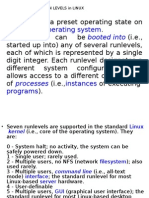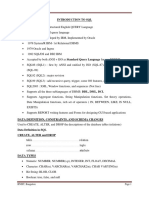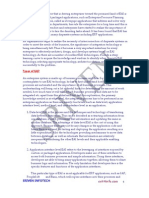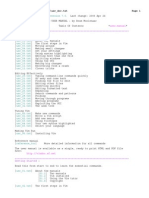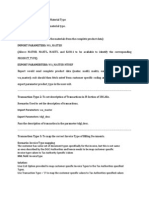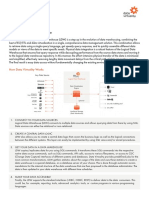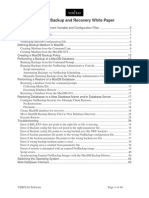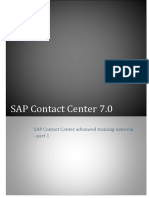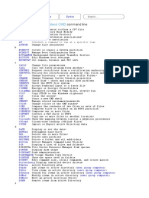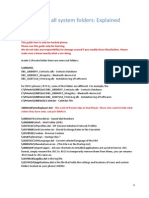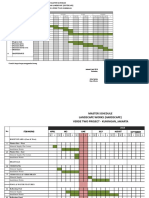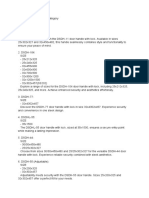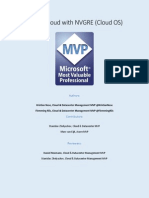Install Cacti (Network Monitoring) on
RHEL/CentOS 7.x/6.x/5.x and Fedora 21-12
Install Wine 1.6.2 Stable in RHEL/CentOS
7.0/6.x/5.x and Fedora 20-12
CentOS 6.4 Step by Step Installation Guide with
Screenshots
30 Useful Linux System Administration Commands
1. Uptime Command
In Linux uptime command shows since how long your system
is running and the number of users are currently logged in and
also displays load average for 1,5 and 15 minutes intervals.
DOWNLOAD FREE LINUX EBOOKS
Complete Linux Command Line Cheat Sheet
The GNU/Linux Advanced Administration Guide
Securing & Optimizing Linux Servers
Linux Patch Management: Keeping Linux Up To
Date
Introduction to Linux A Hands on Guide
Understanding the Linux Virtual Memory
#uptime
08:16:26up22min,1user,loadaverage:0.00,0
.03,0.22
Manager
Linux Bible Packed with Updates and Exercises
A Newbies Getting Started Guide to Linux
Linux from Scratch Create Your Own Linux OS
Linux Shell Scripting Cookbook, Second Edition
Check Uptime Version
Uptime command dont have other options other than uptime
Securing & Optimizing Linux: The Hacking
Solution
User Mode Linux Understanding and
Administration
�and version. It gives information only in hours:mins if it less
than 1 day.
[tecmint@tecmint~]$uptimeV
procpsversion3.2.8
2. W Command
It will displays users currently logged in and their process
along-with shows load averages. also shows the login name,
tty name, remote host, login time, idle time, JCPU, PCPU,
command and processes.
#w
08:27:44up34min,1user,loadaverage:0.00,0
.00,0.08
USERTTYFROMLOGIN@IDLE
JCPUPCPUWHAT
tecmintpts/0192.168.50.107:590.00s
0.29s0.09sw
Available options
�-h : displays no header entries.
-s : without JCPU and PCPU.
-f : Removes from field.
-V : (upper letter) Shows versions.
3. Users Command
Users command displays currently logged in users. This
command dont have other parameters other than help and
version.
#users
tecmint
4. Who Command
who command simply return user name, date, time and host
information. who command is similar to w command. Unlike w
command who doesnt print what users are doing. Lets
illustrate and see the different between who and w commands.
#who
tecmintpts/02012091807:59(192.168.50.
�1)
#w
08:43:58up50min,1user,loadaverage:0.64,0
.18,0.06
USERTTYFROMLOGIN@IDLE
JCPUPCPUWHAT
tecmintpts/0192.168.50.107:590.00s
0.43s0.10sw
Who command Options
-b : Displays last system reboot date and time.
-r : Shows current runlet.
-a, all : Displays all information in cumulatively.
5. Whoami Command
whoami command print the name of current user. You can also
use who am i command to display the current user. If you are
logged in as a root using sudo command whoami command
return root as current user. Use who am i command if you
want to know the exact user logged in.
#whoami
�tecmint
6. ls Command
ls command display list of files in human readable format.
#lsl
total114
drxrxrx.2rootroot4096Sep1808:46bin
drxrxrx.5rootroot1024Sep815:49boot
Sort file as per last modified time.
#lsltr
total40
rwrr.1rootroot6546Sep1718:42install.
log.syslog
rwrr.1rootroot22435Sep1718:45install.
log
rw.1rootroot1003Sep1718:45anaconda
ks.cfg
For more examples of ls command, please check out our
�article on 15 Basic ls Command Examples in Linux.
7. Crontab Command
List schedule jobs for current user with crontab command and
-l option.
#crontabl
0010***/bin/ls>/ls.txt
Edit your crontab with -e option. In the below example will open
schedule jobs in VI editor. Make a necessary changes and quit
pressing :wq keys which saves the setting automatically.
#crontabe
For more examples of Linux Cron Command, please read our
earlier article on 11 Cron Scheduling Task Examples in Linux.
8. Less Command
less command allows quickly view file. You can page up and
down. Press q to quit from less window.
�#lessinstall.log
Installingsetup2.8.1410.el6.noarch
warning:setup2.8.1410.el6.noarch:HeaderV3RSA/
SHA256Signature,keyIDc105b9de:NOKEY
Installingfilesystem2.4.302.1.el6.i686
Installingcacertificates2010.633.el6.noarch
Installingxmlcommon0.6.332.el6.noarch
Installingtzdata2010l1.el6.noarch
Installingisocodes3.162.el6.noarch
9. More Command
more command allows quickly view file and shows details in
percentage. You can page up and down. Press q to quit out
from more window.
#moreinstall.log
Installingsetup2.8.1410.el6.noarch
warning:setup2.8.1410.el6.noarch:HeaderV3RSA/
SHA256Signature,keyIDc105b9de:NOKEY
Installingfilesystem2.4.302.1.el6.i686
Installingcacertificates2010.633.el6.noarch
Installingxmlcommon0.6.332.el6.noarch
Installingtzdata2010l1.el6.noarch
Installingisocodes3.162.el6.noarch
More(10%)
�10. CP Command
Copy file from source to destination preserving same mode.
#cppfileAfileB
You will be prompted before overwrite to file.
#cpifileAfileB
11. MV Command
Rename fileA to fileB. -i options prompt before overwrite. Ask
for confirmation if exist already.
#mvifileAfileB
12. Cat Command
cat command used to view multiple file at the same time.
#catfileAfileB
�You combine more and less command with cat command to
view file contain if that doesnt fit in single screen / page.
#catinstall.log|less
#catinstall.log|more
For more examples of Linux cat command read our article on
13 Basic Cat Command Examples in Linux.
13. Cd command (change directory)
with cd command (change directory) it will goes to fileA
directory.
#cd/fileA
14. pwd command (print working
directory)
pwd command return with present working directory.
�#pwd
/root
15. Sort command
Sorting lines of text files in ascending order. with -r options will
sort in descending order.
#sortfileA.txt
#sortrfileA.txt
16. VI Command
Vi is a most popular text editor available most of the UNIX-like
OS. Below examples open file in read only with -R option. Press
:q to quit from vi window.
#viR/etc/shadows
17. SSH Command (Secure Shell)
SSH command is used to login into remote host. For example
�the below ssh command will connect to remote host
(192.168.50.2) using user as narad.
#sshnarad@192.168.50.2
To check the version of ssh use option -V (uppercase) shows
version of ssh.
#sshV
OpenSSH_5.3p1,OpenSSL1.0.0fips29Mar2010
18. Ftp or sftp Command
ftp or sftp command is used to connect to remote ftp host. ftp
is (file transfer protocol) and sftp is (secure file transfer
protocol). For example the below commands will connect to
ftp host (192.168.50.2).
#ftp192.168.50.2
#sftp192.168.50.2
�Putting multiple files in remote host with mput similarly we can
do mget to download multiple files from remote host.
#ftp>mput*.txt
#ftp>mget*.txt
19. Service Command
Service command call script located at /etc/init.d/ directory
and execute the script. There are two ways to start the any
service. For example we start the service called httpd with
service command.
#servicehttpdstart
OR
#/etc/init.d/httpdstart
20. Free command
Free command shows free, total and swap memory
information in bytes.
#free
�totalusedfreeshared
bufferscached
Mem:10308007359442948560
51648547696
/+buffers/cache:136600894200
Swap:206437602064376
Free with -t options shows total memory used and available to
use in bytes.
#freet
totalusedfreeshared
bufferscached
Mem:10308007360962947040
51720547704
/+buffers/cache:136672894128
Swap:206437602064376
Total:30951767360962359080
21. Top Command
top command displays processor activity of your system and
also displays tasks managed by kernel in real-time. Itll show
processor and memory are being used. Use top command with
u option this will display specific User process details as
shown below. Press O (uppercase letter) to sort as per
desired by you. Press q to quit from top screen.
�#toputecmint
top11:13:11up3:19,2users,loadaverage:0
.00,0.00,0.00
Tasks:116total,1running,115sleeping,0st
opped,0zombie
Cpu(s):0.0%us,0.3%sy,0.0%ni,99.7%id,0.0%wa
,0.0%hi,0.0%si,0.0%st
Mem:1030800ktotal,736188kused,294612kfr
ee,51760kbuffers
Swap:2064376ktotal,0kused,2064376kfr
ee,547704kcached
PIDUSERPRNIVIRTRESSHRS%CPU%MEM
TIME+COMMAND
1889tecmint200114681648920S0.00.2
0:00.59sshd
1890tecmint200512416681416S0.00.2
0:00.44bash
6698tecmint200116001668924S0.00.2
0:01.19sshd
6699tecmint200512415961352S0.00.2
0:00.11bash
For more about top command weve already compiled a list of
12 TOP Command Examples in Linux.
22. Tar Command
tar command is used to compress files and folders in Linux.
For example the below command will create a archive for
�/home directory with file name as archive-name.tar.
#tarcvfarchivename.tar/home
Introduction to Linux - A Hands on Guide - Free eBook
Download Now
To extract tar archive file use the option as follows.
#tarxvfarchivename.tar
To understand more about tar command weve created a
complete how-to guide on tar command at 18 Tar Command
Examples in Linux.
23. Grep Command
grep search for a given string in a file. Only tecmint user
displays from /etc/passwd file. we can use -i option for
ignoring case sensitive.
#greptecmint/etc/passwd
tecmint:x:500:500::/home/tecmint:/bin/bash
JoinOver95000+LinuxUsers
SHARE
57,739
114
3,201
25,639
Enter your email to get latest Linux Howto's
�24. Find Command
Enter Your Email Address :)
1.2k
20 Linux YUM (Yellowdog Updater, Modified) Commands
Find command used to search files, strings and directories.
The below example of find command search tecmint word in /
partition and return the output.
149
#find/nametecmint
/var/spool/mail/tecmint
/home/tecmint
/root/home/tecmint
38
58
For complete guide on Linux find command examples fount at
35 Practical Examples of Linux Find Command.
25. lsof Command
lsof mean List of all open files. Below lsof command list of all
opened files by user tecmint.
#lsofutecmint
COMMANDPIDUSERFDTYPEDEVICESIZE/OF
FNODENAME
sshd1889tecmintcwdDIR253,0409
62/
sshd1889tecminttxtREG253,053233
COMMENTS
Subscribe
�6298069/usr/sbin/sshd
sshd1889tecmintDELREG253,0
412940/lib/libcom_err.so.2.1
sshd1889tecmintDELREG253,0
393156/lib/ld2.12.so
sshd1889tecmintDELREG253,0
298643/usr/lib/libcrypto.so.1.0.0
sshd1889tecmintDELREG253,0
393173/lib/libnsl2.12.so
sshd1889tecmintDELREG253,0
412937/lib/libkrb5support.so.0.1
sshd1889tecmintDELREG253,0
412961/lib/libplc4.so
For more lsof command examples visit 10 lsof Command
Examples in Linux.
26. last command
With last command we can watch users activity in the system.
This command can execute normal user also. It will display
complete users info like terminal, time, date, system reboot or
boot and kernel version. Useful command to troubleshoot.
#last
tecmintpts/1192.168.50.1TueSep180
8:50stillloggedin
tecmintpts/0192.168.50.1TueSep180
�7:59stillloggedin
rebootsystemboot2.6.32279.el6.iTueSep180
7:5411:38(03:43)
rootpts/1192.168.50.1SunSep161
0:40down(03:53)
rootpts/0:0.0SunSep161
0:3613:09(02:32)
roottty1:0SunSep161
0:07down(04:26)
rebootsystemboot2.6.32279.el6.iSunSep160
9:5714:33(04:35)
naradpts/2192.168.50.1ThuSep130
8:07down(01:15)
You can use last with username to know for specific users
activity as shown below.
#lasttecmint
tecmintpts/1192.168.50.1TueSep180
8:50stillloggedin
tecmintpts/0192.168.50.1TueSep180
7:59stillloggedin
tecmintpts/1192.168.50.1ThuSep130
8:07down(01:15)
tecmintpts/4192.168.50.1WedSep121
0:1212:29(02:17)
27. ps command
�ps command displays about processes running in the system.
Below example show init process only.
#psef|grepinit
root10007:53?00:00:04/sb
in/init
root75086825011:48pts/100:00:00gre
pinit
28. kill command
Use kill command to terminate process. First find process id
with ps command as shown below and kill process with kill -9
command.
#psef|grepinit
root10007:53?00:00:04/sb
in/init
root75086825011:48pts/100:00:00gre
pinit
#kill97508
29. rm command
�rm command used to remove or delete a file without prompting
for confirmation.
#rmfilename
Using -i option to get confirmation before removing it. Using
options -r and -f will remove the file forcefully without
confirmation.
#rmitest.txt
rm:removeregularfile`test.txt'?
30. mkdir command example.
mkdir command is used to create directories under Linux.
#mkdirdirectoryname
This is a handy day to day useable basic commands in Linux /
Unix-like operating system. Kindly share through our comment
box if we missed out.
�If you have any questions or problems regarding this article and
want help within 24 Hours? Ask Now
Support TecMint: Did you find this tutorial helpful?. Please help to keep it alive
by donating. Every cent counts! - Donate Now
Ravi Saive
View all Posts
Simple Word a Computer Geek and Linux Guru who loves
to share tricks and tips on Internet. Most Of My Servers runs on Open
Source Platform called Linux.
Your name can also be listed here. Got a tip? Submit it
here to become an TecMint author.
Receive Your Free Complimentary eBook NOW! - Can You Run It On Linux?
10 Vital Apps You Will Want When You Switch
Download Free Linux eBooks
PREVIOUS STORY
NEXT STORY
Install VLC 2.0.5 in Ubuntu 12.10
Simple Steps to Upgrade Linux
and Linux Mint 14
Mint 13 (Maya) to Linux Mint 14
(Nadia)
YOU MAY ALSO LIKE...
16
10 sFTP Command
Examples to Transfer
7 Quirky ls Command
Tricks Every Linux User
44
Rename A Command
Line Tool For Renaming
�Files on Remote
Servers in Linux
Should Know
Multiple Files in Linux
23 MAR, 2015
10 OCT, 2013
6 FEB, 2014
58 RESPONSES
Comments 58
Yoander
Pingbacks 0
October 26, 2015 at 8:20 pm
Another useful commands: arch, dmidecode
Reply
madhavakalikivayi
October 16, 2015 at 11:33 pm
Its useful information
Reply
Madhu Prasad
October 9, 2015 at 4:50 pm
great post very useful information.
Reply
sunil verma
February 27, 2015 at 11:20 pm
i want to share my knowledge to the people because i want all people grow fast
in their life
Reply
Ravi Saive
March 2, 2015 at 12:26 pm
@Sunil,
what kind of knowledge you want to share with the people? can you brief
us..
�Reply
Tomas
November 2, 2014 at 4:15 pm
This article is about useful commands for SYSADMINS and has no mention of
rsync? Seriously? :)
Reply
Ateeq
October 21, 2014 at 12:50 am
Hi,
I have a basic knowledge on Linux and Unix server. Want to enhance my
knowledge fully and become a Unix Admin or Linux Engineer. Could someone
please refer me the best book which is available in India Bangalore( Indian author
is better)
Reply
GrimReaper
November 2, 2014 at 5:30 am
There are enough low wage Indians thinking they know how to administer
Unix systems. Yet there foreign masters do not trust them to execute any
command without prior approval. I witnessed this scenario many times
while waiting for the Indian to call the manager at the client for approval.
Besides you can find the titles of a plethora of Unix administration books
via any Internet search engine.
Reply
Older Comments
LEAVE A REPLY
Name *
Email *
�Website
Comment
Post Comment
LINUX MONITORING TOOLS
LINUX INTERVIEW QUESTIONS
Monitor Server Logs in Real-Time with
Log.io Tool on RHEL/CentOS 7/6
10 Useful Interview Questions and
Answers on Linux Shell Scripting
28 OCT, 2014
26 MAY, 2014
How to Install vnStat and vnStati to
Monitor Network Traffic in
RHEL/CentOS 7
4 APR, 2015
OPEN SOURCE TOOLS
Is Linux Operating System Virus Free?
1 AUG, 2013
10 Interview Questions and Answers on
Various Commands in Linux
Install GLPI (IT and Asset
Management) Tool with Fusion
Inventory in Debian Linux
22 MAR, 2014
13 MAY, 2015
�Mytop (MySQL Database Monitoring) in
RHEL/CentOS 6.3/5.6 and Fedora
17/12
8 NOV, 2012
How to Limit the Network Bandwidth
Used by Applications in a Linux System
with Trickle
10 Useful SSH (Secure Shell) Interview
Questions and Answers
15 MAR, 2014
Create Your Own Instant
Messaging/Chat Server Using
Openfire in Linux
27 DEC, 2013
11 Advance MySQL Database
Interview Questions and Answers for
Linux Users
Wireshark Network Protocol Analyzer
Tool for RHEL/CentOS/Fedora
17 JUN, 2014
16 AUG, 2012
25 FEB, 2015
Tecmint: Linux Howtos, Tutorials & Guides 2015. All Rights Reserved.
This work is licensed under a (cc) BY-NC
The material in this site cannot be republished either online or offline,
without our permission.





